
| SM Publications |
| Silver Salon Forums - The premier site for discussing Silver. |
| SMP | Silver Salon Forums | SSF - Guidelines | SSF - FAQ | Silver Sales |

|
|
|
The Silver Salon Forums
Since 1993 Over 11,793 threads & 64,769 posts !! General Silver Forum
|
| REGISTER (click here) |
How to Post Photos
|

|
 SMP Silver Salon Forums SMP Silver Salon Forums
  General Silver Forum General Silver Forum
  A Useful Blade A Useful Blade
|
| next newest topic | next oldest topic |
| Author | Topic: A Useful Blade |
|
Scott Martin Forum Master Posts: 11520 |
  
For some 350 years, branches of the Thurn and Taxis family operated private mail delivery services across Europe. That changed on May 1, 1840, when Britain introduced prepaid envelopes and adhesive postage stamps. This was the beginning of the modern postal service and inspired the entrepreneur who saw the potential for a new desk accoutrement and so created the letter opener. Manufacturers picked up the idea and some based the design of these new letter openers on the side arm, which was an old method for breaking the wax seal on letters. This accounts for the resemblance of many to swords or daggers. The scabbards or grips of the small versions being decorated like the full size counterparts such as with niello, an ancient decorative craft popular as a contrast between the shiny silver and the deep black alloy and used in Europe, Russia, Turkey and Thailand (Figures 1 & 1a). 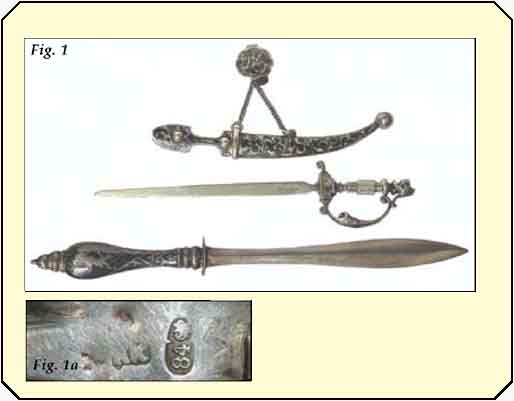 Fig. 1. Top: A Russian silver and niello letter opener marked "kk." It measures 4 ½ inches and weighs 20.4 grams, dated about 1880. Middle: The maker did not punch his mark on the sword with a cast curved hand guard topped with an open helmet finial that originates from the Netherlands in 833 silver and dated 1931. It is 5 7/8 inches in length and weighs 24 grams. Bottom: A dagger from Thailand features a dancing Deva on the grip with a niello background. It measures 7 7/8 inches and weighs 16.6 grams, marked on the guard with "Siam" and "Sterling" so probably dates from the mid 1940s. Fig. 1a. Russian silver and niello letter opener (opener on top) by an unidentified maker's mark "kk," probably assayed in Moscow. The new implement took its place next to the paper knife which was used for making neat folds, trimming notepaper, and for making handmade envelopes as well as cutting the untrimmed pages of books. These deckle edge books were a result of publishers having difficulty supplying the demand for reading material due to the increase in literacy, so they sold the books with the pages folded but not guillotined. Silver blade paper knives were popular but other materials could achieve the same purpose such as those that incorporated New Zealand greenstone (Figures 2 & 2a). 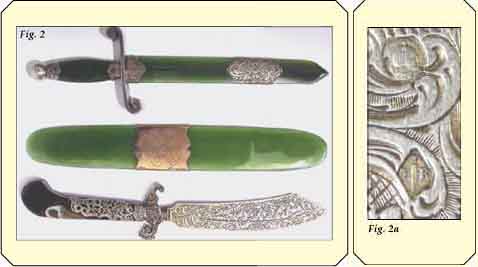 Fig. 2. Bottom: From France is a nineteenth century curved blade with pierced decoration and a sea horse hand guard in 800 silver, 7 3/8 inches with an agate grip, possibly made by Longuet & Bardies of Paris after 1887. Middle: Tourist conscious New Zealand produced many souvenirs, one being a greenstone blade measuring 7 5/8 inches with an ornate 9 ct ferrule engraved "Mizpah." Top: Mounted in silver but unmarked is a greenstone or nephrite sword, the engraving is similar to the work of F.F. Grady of Wellington, New Zealand and dated about 1890. Fig. 2a. Bottom opener: possibly the mark of Longuet & Bardies of Paris, after 1887, together with the French second standard punch for 800 silver. The letter opener and paper knife are similar with the letter opener generally smaller than a paper knife, having a blade with a point and with an ornate finial or grip. Misusing either of these blades may cause damage, which spoils its appearance and reduces its value. Over time, these bladed implements became popular as gifts, souvenirs, presentation or promotional pieces; as well as to commemorate important events or anniversaries. Coronations, including those of king Haakon VII and Queen Maud of Norway in 1905 and Queen Elizabeth in 1954, are among the celebrated events in which letter openers were produced (Figures 3, 3a & 3b). Anniversaries or presentation pieces often need research to establish the event celebrated. It is not always successful and the reason for the Royal Danish Bridge & Harbor Master's arms on the Georg Jensen letter opener remains unknown. Other events are easier to identify. For example, L. Hooyraas Silver Manufactory of Schoonhoven made the commemorative letter opener with a windmill finial for koninklije Luchtvaartmaatschappij NV or kLM, the Royal dutch Airline in 1948, the year of Queen Juliana's coronation. The previous year marked the 350th anniversary of Cornelis Claesz's first expedition to the East Indies, and droog, Zegwaart & van Herwaarde of Haarlem celebrated this occasion with a commemorative silver letter opener featuring a sailing ship (Figures 4, 4a, 4b & 4c). 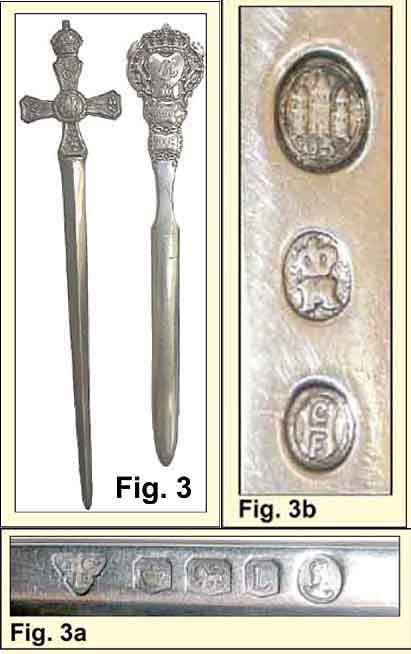 Fig. 3. Right: Commemorative piece from the coronation of King Haakon VII and Queen Maud when they ascended the throne to become the first monarchs of Norway after independence in 1905. It was produced by A. Michelsen of Copenhagen and weighs 52 grams. Left: A memento of Queen Elizabeth's coronation in 1954 weighs 60.5 grams and measures 8 ½ inches with a crown finial and floral emblems of England, Ireland, Wales and Scotland on the arms of the cross. It has stamp of the Goldsmiths & Silversmiths Co. Ltd. with the Sheffield assay office marks and the Queen's head. Fig. 3a. Left opener: the Goldsmiths & Silversmiths Co. Ltd. of 112 Regent Street, London with the Sheffield assay office mark dated 1954 together with the Queen's head punch. Fig. 3b. Right opener: Anton Michelsen of Copenhagen mark together with that of the assay master C.F. Heise and the Danish state control mark with the last two numbers of the year of assay, being 1905. Fig. 4a. Right opener: the mark of L. Hooyraas Silver Manufactory of Schoonhoven and the crowned 1948 date stamp. Fig. 4b. Middle opener: "Georg Jensen in a circle of dots," a mark that came into use after 1945, and "Sterling" and "denmark" punches. Fig. 4c. Left opener: Droog, Zegwaart & van Herwaarde of Haarlem with the Dutch assay marks and dated 1947. IP: Logged |
|
Scott Martin Forum Master Posts: 11520 |
  
Souvenir items were ideal as an aide-mémoire of travels undertaken or as gifts for those who did not make the journey (Figure 5). An Australian memento, the boomerang, was given as a gift with the hope that the recipient will return. These came in various sizes and may have features such as a blister pearl (Figure 6). Another letter opener with an unusual shaped blade was from a spouse celebrating a 25th anniversary inscribed with a reminder of her husband's years "spent in the work of the Lord in Amsterdam" (Figure 7). However, the origin of the plastic bladed knife with the dramatic scene of a troika on a forest trail chased by wolves is unknown as it has a 900 standard mark, the Russian import stamp but no maker's mark (Figures 8 & 8a).  Fig. 5. Left: An early plastic blade souvenir for visitors to the Frisian Islands, 7 7/8 inches, with an attached coat of arms in silver of Terschelling. Middle: On its original card is a souvenir of Ireland with a finial featuring green stones set into a shamrock and harp made by J. Cooke & Son, Birmingham in 1906. Right: With a mother of pearl blade is this late nineteenth century piece with an unmarked silver grip, 23.2 grams and 7 7/8 inches.
Fig. 6b. Right opener: the mark of the retailer Fairfax & Roberts with the makers mark of W.J. Sanders both of Sydney with the standard marks. Fig. 7a. The partially rubbed marks include the makers mark and the year mark. Fig. 8a. Russian import mark in use 1908-1917 and the standard mark "900" but no maker's mark. IP: Logged |
|
Scott Martin Forum Master Posts: 11520 |
  
Incorporated in some finials are the promotional medallions, as in the example shown and was for the Maersk's shipping routes. Others have coins that long ceased to be legal tender and worth only scrap value so the date of these coins bears no relationship to the year of manufacture of the item in which incorporated (Figures 9, 9a, 9b & 9c). 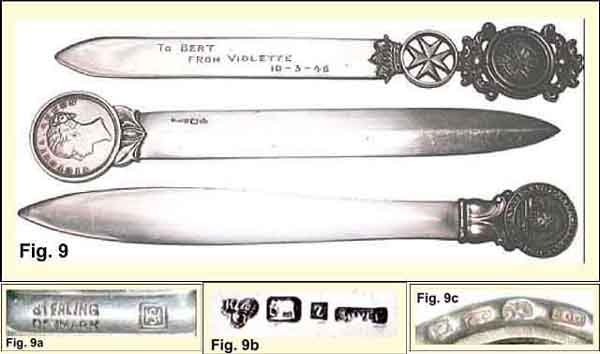 Fig. 9. Bottom: From the Maersk Shipping Line of Denmark is a die struck promotional piece that is 48 grams and measures 7 7/8 inches made by Horsens Silverware Factory after 1947. Middle: Hamilton & Co of Calcutta used an 1840 British East India one Rupee coin in the finial of this piece dated 1961; the date of the coins usually bears no relationship to the year of manufacture. Top: Coins from the period of the Knights of St. John on Malta that ended in 1799 were popular to include in mementos of a visit to the islands; Joseph Cassar made the 46.8 gram piece with a cast finial and a 1946 presentation inscription. Fig. 9a. Bottom opener: the makers mark of Horsens Silverware Factory of Denmark. Fig. 9b. Middle opener: Hamilton & Co of Calcutta house marks included the elephant, together with the date mark for 1961 and the metal standard. Fig. 9c. Top opener: Joseph Cassar makers mark, the Maltese Cross and an 800 stamp but the date stamp is uncertain. A bladed item that pre-existed for use in the library was the page-turner: a wide, flat, bull nose blade of silver, wood, ivory or similar material about 11 ½ inches long often with an ornate grip and used for turning the page of large books (Figures 10, 10a & 10b). These page-turners came into general use following the opening of secular libraries such as Oxford university's Bodleian (1602), the British Library (1759) and the united States' Library of Congress (1800). With improved education, increase in literacy, and greater public access to printed material, the lending library and later the free public library came into being. An outcome of the increase and availability of printed material was the reduction in the physical size of books resulting in the page-turner becoming obsolete. 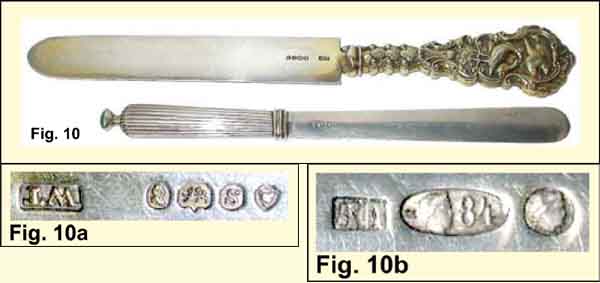 Fig. 10. Top: William Theobalds of London had the page-turner assayed in 1833. The silver gilt piece has an ornate grip featuring birds, weighs 110 grams and is 9 inches. Bottom: A silver page-turner marked "kN" with the St. Petersburg assay mark in use between 1908 and 1917, 28.2 grams and 7 ½ inches and set with a green cabochon stone in the finial. Fig. 10a. Top opener: inverted is William Theobalds mark to the London assay marks dated 1833 together with the King's head showing payment of the duty. Fig. 10b. Bottom opener: the unidentified maker's mark "kN" assayed in St. Petersburg assayed mark between 1908 and 1917 in 84/96 zolotniks or 875 silver. Manufacturers seeking new customers and markets offered items with combined various utilitarian usages, such as a magnifying glass or a marked off ruler, and the list continues. In the late nineteenth century, a paper knife cum letter opener appeared and subsequently from this innovation came the smaller, ever-popular gift item, the page marker. These came in different shapes and sizes with various finials; Aidie & Lovekin obviously had the blade of one assayed in Birmingham before marrying it to the finial featuring a bear, probably imported from Switzerland (Figure 11). A collection of different shapes and styles of bookmarks from different sources makes for a diverse and interesting display (Figure 12). There was another innovation from the turn of the twentieth century - the boxed desk set. These sets made ideal coming-of-age gifts for the young woman that contained a letter opener, pen, pencil, and a personal seal (Figure 13). 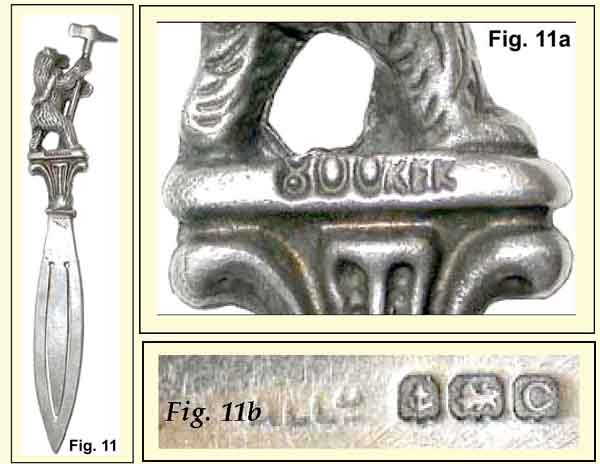 Fig. 11. The book mark with the 800 bear finial, probably from Switzerland, married to the blade by Adie & Lovekin Ltd of Birmingham. Fig. 11a. The bear finial is stamped "800" with an unidentified maker's mark of "kEk," possibly imported from Switzerland. Fig. 11b. The mark on the blade of Adie & Lovekin Ltd of Regent Street, Birmingham, assayed and dated 1927. In association with other skilled workers, silversmiths from diverse places used their imagination to create a wide range of bladed items that are both useful and decorative. Many silver finials were cast for strength and added weight as seen on some of the examples illustrated. A check of the Internet reveals the large number and variety of paper knives, letter openers and book marks available in a wide range of materials and prices. Acknowledgement: BIBLIOGRAPHY
Fred Sinfield is an Australian based freelance researcher, author, and photographer. IP: Logged |
|
Scott Martin Forum Master Posts: 11520 |
  
This article was posted because it came up in another post/thread. See: MARK ID (click here) Thank you Kayvee for the suggestion. IP: Logged |
|
Scott Martin Forum Master Posts: 11520 |
  
Because we permit high degree of anonymity at the SSF, I can't be sure about a recent suggestion that Fred Sinfield is a member. Fred if you are a member and would like to provide me with better copies of the images and/or a follow up for the article please contact me via email (info@SMPub.com). Please make sure the subject line of the email begins with the word SILVER or there is a chance your email will be lost as SPAM. Thanks IP: Logged |
|
adelapt Posts: 418 |
  
I can tell you that our friend Fred Sinfield died last year. IP: Logged |
|
Scott Martin Forum Master Posts: 11520 |
  
I'm very sorry to hear that. IP: Logged |
|
jprice33 Posts: 204 |
  
as printed in the 2008 Nov/Dec issue of Silver Magazine Frederic Sinfield (1938-2008) IP: Logged |
All times are ET | next newest topic | next oldest topic |
  |
|
Ultimate Bulletin Board 5.46a
|
1. Public Silver Forums (open Free membership) - anyone with a valid e-mail address may register. Once you have received your Silver Salon Forum password, and then if you abide by the Silver Salon Forum Guidelines, you may start a thread or post a reply in the New Members' Forum. New Members who show a continued willingness to participate, to completely read and abide by the Guidelines will be allowed to post to the Member Public Forums. 2. Private Silver Salon Forums (invitational or $ donation membership) - The Private Silver Salon Forums require registration and special authorization to view, search, start a thread or to post a reply. Special authorization can be obtained in one of several ways: by Invitation; Annual $ Donation; or via Special Limited Membership. For more details click here (under development). 3. Administrative/Special Private Forums (special membership required) - These forums are reserved for special subjects or administrative discussion. These forums are not open to the public and require special authorization to view or post. |
|
copyright © 1993 - 2022
SM Publications
All Rights Reserved. Legal & Privacy Notices |